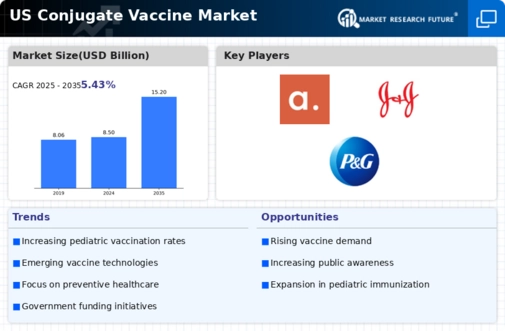Advancements in Vaccine Research
Advancements in vaccine research and development are significantly impacting the conjugate vaccine market. Innovative technologies, such as recombinant DNA technology and adjuvant formulations, are enhancing the efficacy and safety profiles of conjugate vaccines. These advancements not only improve the immune response but also reduce the number of doses required for effective immunization. As a result, healthcare providers are more likely to recommend these vaccines, leading to increased uptake among patients. The conjugate vaccine market stands to benefit from these scientific breakthroughs, as they may lead to the introduction of new and improved vaccine products that meet the evolving needs of the population.
Government Initiatives and Funding
Government initiatives play a pivotal role in shaping the conjugate vaccine market. In the United States, federal and state governments have allocated substantial funding to support vaccination programs. For instance, the Vaccines for Children (VFC) program provides free vaccines to eligible children, thereby increasing access to conjugate vaccines. Additionally, the Centers for Disease Control and Prevention (CDC) actively promotes vaccination through various campaigns, which further enhances public participation. The financial backing and policy support from government entities are likely to bolster the conjugate vaccine market, ensuring that vaccines remain accessible and affordable for all segments of the population.
Increased Awareness of Vaccine Benefits
The conjugate vaccine market is experiencing growth due to heightened awareness regarding the benefits of vaccination among the population. Public health campaigns and educational initiatives have effectively communicated the importance of vaccines in preventing infectious diseases. This awareness has led to increased vaccination rates, particularly in pediatric populations. According to recent data, vaccination coverage in children has reached approximately 90%, which is crucial for herd immunity. As parents become more informed about the risks associated with vaccine-preventable diseases, the demand for conjugate vaccines is likely to rise. This trend is expected to drive the conjugate vaccine market forward, as healthcare providers and policymakers emphasize the necessity of immunization in safeguarding public health.
Rising Incidence of Infectious Diseases
The conjugate vaccine market is influenced by the rising incidence of infectious diseases, particularly among vulnerable populations. Recent reports indicate an uptick in cases of diseases such as meningitis and pneumonia, which are preventable through conjugate vaccination. This increase in disease prevalence has prompted healthcare providers to advocate for higher vaccination rates. As the public becomes more aware of the potential health risks associated with these diseases, the demand for conjugate vaccines is expected to grow. Consequently, this trend may drive the conjugate vaccine market, as manufacturers respond to the urgent need for effective immunization solutions.
Collaboration Between Public and Private Sectors
Collaboration between public and private sectors is fostering growth in the conjugate vaccine market. Partnerships between government agencies, non-profit organizations, and pharmaceutical companies are facilitating research, development, and distribution of vaccines. These collaborations often result in shared resources and expertise, which can accelerate the development of new conjugate vaccines. Furthermore, joint initiatives aimed at increasing vaccination coverage are likely to enhance public trust in vaccines. As these partnerships continue to evolve, they may strengthen the conjugate vaccine market, ensuring that innovative vaccines are developed and made available to the population in a timely manner.

















Leave a Comment